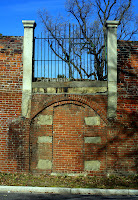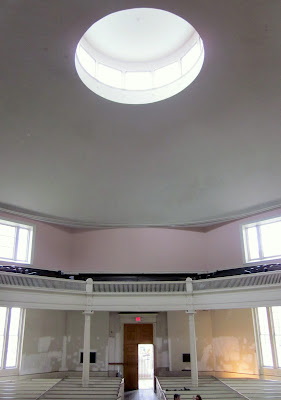Richard A. Etlin was one of my architectural history professors at
Kentucky.
Being in the midst of writing a book, much of his research ended up in our curriculum.
The book would later be titled “The Architecture of Death”.
For those two semesters his students were confronted with images of Claude LeDoux and Etienne-Louis Boullee.
These two late-18
th century French Architects were exploring funerary design.
Along with mausoleums and other architectural forms, they were re-thinking how cemeteries could be used as thoughtful public park land.

I don’t know if this movement ever made its way to
Richmond, but there are (to my eye) some connections in three notable cemeteries of that time period:
St. John’s,
Hollywood, and Shockoe Hill.
Hollywood is the most scenic and famous as a resting place for presidents.
St. John’s is the oldest and historic due to the “Liberty-or-Death” speech given by Patrick Henry.
The least known of these is Shockoe Hill which began in 1822 when the church yard at
St. John’s was at capacity.
The most famous “resident” of Shockoe Hill is John Marshall who shaped the early Supreme Court into the equal third branch of our federal government. Other notables are buried there; names that locals would instantly recognize: Mayo and Foushee.
A separate Hebrew cemetery was created across Hospital Street from the main grounds. This one is dense and more scenic with a rolling topography. It may seem a strange comparison, but both parts of Shockoe Hill are almost urban. The language I would use to describe urban design fits well in describing a cemetery.

There is a formal plan that defines pathways and districts.
These paths are paved grids and pastoral trails.
Walls surround the grounds, separating the landscape from the street and some of the traffic.
There are fences and raised plots that define boundaries and trees that also create canopy and enclosure.
Monuments take many expressive forms, showing personality and era – much like indigenous architecture does.
Some monuments are literal portals or gateways – a subtle reference to the hereafter.
Others have showy personalities while others are humble stone markers in the ground.
In a cemetery this old, it is easier to think about it in a historical context – unlike newer ones in the suburbs. The character and form of the old brick walls always attracted my eye. It is also curious that the wall is at a fairly constant level as seen from the inside. When viewed from the surrounding streets, the brick wall ranges from as low as 4 feet to over 20 feet in height. Gated portals face each street including one on 4th that appears to once have been a staired entry. The "ghost" of that missing stair is imprinted on the brick and a bricked-up arch is below. A little research at the Valentine museum would probably reveal what was once there.

This cemetery partially surrounds one elegant building constructed 150 years ago – the Shockoe Hill Almshouse.
This structure was originally a place to house and care for the poor of
Richmond.
During the Civil War, it was converted into a Confederate hospital.
Draw your own conclusions about the choice of locations for these uses. Most famously, it can be seen in a Matthew Brady image of that era.
The cemetery is visible in the photo's foreground.
I have some personal work-history with this building. In 1983, I was part of the design team that converted the unused building into affordable senior housing. It is still being used for that purpose.
Today, a cemetery is seldom considered to be a desirable neighbor. Shockoe Hill was cut off from the public consciousness when Interstate 95 was carved around it on two sides - separating it from the business district. A public housing project was placed on another side along with the renovated senior housing project mentioned earlier. The grounds are well cared for but it’s sad to see this little place of history get so little respect.
Take some time to walk around one sunny day.





